Greyhound racing in the United Kingdom
Greyhound racing is a popular industry in Great Britain with attendances at around 3.2 million at over 5,750 meetings, in 2007 alone. There are 26 licensed stadiums in Britain, it is a Parimutuel betting tote system with on-course and off-course betting available, with a turnover of £75,100,000.[1]

History
Greyhound racing as it is seen today has evolved from a form of hunting called coursing, in which a dog runs after a live game animal – usually a rabbit or hare. The first official coursing meet was held in 1776 at Swaffham, Norfolk. The rules of the Swaffham Coursing Society specified that only two greyhounds were to course a single hare and that the hare was to be given a head start of 240 yards.[2]
Coursing by proxy with an artificial lure was introduced at Hendon, on September 11, 1876. Six dogs raced over a 400-yard straight course, chasing an artificial hare riding. This was the first attempt of introducing mechanical racing to the UK, however it did not catch on at the time.[3]
The oval track and mechanical hare were introduced to Britain, in 1926, by American, Charles Munn, in association with Major Lyne-Dixson, a key figure in coursing. Finding other supporters proved to rather difficult however and with the General Strike of 1926 looming, the two men scoured the country in an attempt to find others who would join them. Eventually they met Brigadier-General Critchley, who in turn introduced them to Sir William Gentle.[4] Between them they raised £22,000 and launched the Greyhound Racing Association.[5] On July 24, 1926, in front of 1,700 spectators, the first greyhound race took place at Belle Vue Stadium where seven greyhounds raced round an oval circuit to catch an electric artificial hare.[6] This marked the first ever modern greyhound race in Great Britain. They then hurried to open tracks in London at the White City Stadium and Harringay Stadium.[6]
Racing
The industry of greyhound racing in Great Britain currently falls under two sectors: that registered by the Greyhound Board of Great Britain (GBGB), and a sector known as 'independent racing' or 'flapping'.[7]
Registered Racing
Registered racing in Great Britain is regulated by the Greyhound Board of Great Britain (GBGB). All in the registered sector are subject to the Greyhound Board of Great Britain (GBGB) Rules of Racing[8] and the Directions of the Stewards, who set the standards for greyhound welfare and racing integrity, from racecourse facilities and trainers' kennels to retirement of greyhounds. Stewards inquiries and then disciplinary action is taken against anyone found failing to comply.[9]
The registered sector consists of 26 racecourses, 884 trainers (as at 2012 end), 4,135 kennel staff, 867 racecourse officials, and in excess of 15,000 greyhound owners with approximately 10,000 greyhounds registered annually for racing.[10]
Independent Racing
Independent racing, also known as 'flapping', is held at nine racecourses. The number of trainers, kennelstaff, owners and greyhounds involved in independent racing is unknown because there is no requirement for central registration or licensing, and no code of practice. In England, standards for welfare or integrity are set by local government, but there is no governing or other regulatory body.
Stadiums
Registered Stadiums
There are 26 Greyhound Board of Great Britain (GBGB) registered stadiums in the UK:[11] 25 are in England and one is in Scotland. There are no extant tracks in Wales or Northern Ireland.
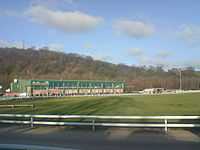
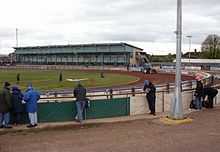
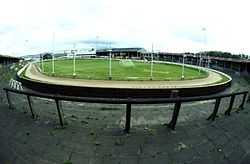
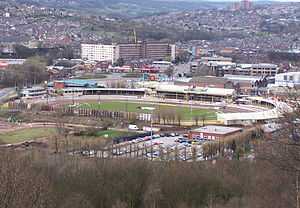
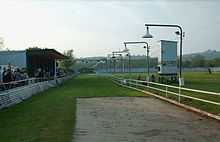
- Belle Vue Stadium, Manchester
- Brighton and Hove Stadium, Brighton and Hove
- Coventry Greyhounds, Coventry
- Crayford Stadium, Bexley, London
- Doncaster Greyhound Stadium, Doncaster
- Hall Green Stadium, Birmingham
- Harlow Stadium, Harlow, Essex
- Henlow Stadium, Central Bedfordshire
- Kinsley Stadium, Wakefield
- Mildenhall Stadium, Mildenhall, Suffolk
- Monmore Green Stadium, Wolverhampton
- Newcastle Stadium, Newcastle upon Tyne
- Nottingham Stadium, Nottingham
- Pelaw Grange, County Durham
- Perry Barr Stadium, Birmingham
- Peterborough Greyhounds, Peterborough
- Poole Stadium, Poole, Dorset
- Romford Stadium, Havering, London
- Shawfield Stadium, South Lanarkshire (the only extant track in Scotland)
- Sheffield Stadium, Sheffield
- Sittingbourne Stadium, Swale, Kent
- Sunderland Stadium, Sunderland
- Swindon Stadium, Swindon
- Towcester Racecourse, Towcester (greyhound track opened December 2014)
- Wimbledon Stadium, Merton, London
- Yarmouth Stadium, Great Yarmouth
Independent Stadiums
There are also a number of independent stadiums:
- Armadale Stadium, West Lothian
- Askern Stadium, Doncaster
- Easington Stadium, Durham
- Halcrow Stadium, Dumfries and Galloway
- Highgate Stadium, Barnsley
- The Valley Stadium, Caerphilly
- Thornton Stadium, Fife
- Wansbeck Stadium, Northumberland
- Wheatley Hill Stadium, Durham
Competitions
There are many types of competitions in Britain,[12] with prize money reaching £15,737,122.[1]
Greyhound Derby
This race must have minimum prize money of £50,000. The competition has six-rounds and attracts around 180 entries each year. There are two derbys in Britain; Scottish Greyhound Derby held at Shawfield Stadium, English Greyhound Derby held at Wimbledon. With a third the Irish Greyhound Derby held at Shelbourne Park open to British greyhounds. There used to be a Welsh Greyhound Derby but the event finished in 1977 following the closure of the track at the Arms Park in Cardiff. In 2010 the Northern Irish Derby was introduced.
Category One Race
These races must have minimum prize money of £12,500. They can be run between one and four rounds but must be completed within a 15 day period, except for special circumstances. In any event the competition must be completed within 18 days.
Category Two Race
These races must have minimum prize money of £5,000. They can be run with one, two or three rounds but must be completed within a 15 day period.
Category Three Race
These races must have minimum prize money of £1,000. They can be run over one or two rounds and within a nine-day period. A category three race can be staged over one day but must have minimum prize money of £500.
Invitation Race
A special type of open race usually staged by the promoter in support on the night of other opens.This will be proposed to the committee by the Greyhound Board or by a promoter, with the racers being invited into the competition rather than the usual process. The minimum prize money for these races is £750.
Minor Open Race
This is any other open race. The minimum added money for these races is £150.
Graded Racing
This is any other race staged at a track, and prize money is varied. This kind of racing is the core of most stadiums and some of the racing can be viewed in betting shops on the BAGS or BEGS service.
Racing Jacket Colours
Greyhound racing in Britain has a standard colour scheme.[13]
- Trap 1 = Red with White numeral
- Trap 2 = Blue with White numeral
- Trap 3 = White with Black numeral
- Trap 4 = Black with White numeral
- Trap 5 = Orange with Black numeral
- Trap 6 = Black & White Stripes with Red numeral
- Trap 7 = Green with Red numeral
- Trap 8 = Yellow and Black with White numeral
A racing jacket worn by a reserve bears an additional letter 'R' prominently on each side.
Welfare
Treatment of Racing Greyhounds
Greyhound racing at registered stadiums in Great Britain is regulated by the Greyhound Board of Great Britain (GBGB)[14] In Britain greyhounds are not kept at the tracks and are instead housed in the kennels of trainers and transported to the tracks to race. Officially licensed kennels have to fall within specific guidelines,[15][16] and are checked regularly by officials to make sure the treatment of racing greyhounds is at the highest level.[17] Greyhounds' health and condition are checked at the track by the track vet before they are permitted to race,[18] and drugs tests are conducted to check for cheating.[19]
Drugs
Drug usage has emerged as a problem in greyhound racing. The racing industry is actively working to prevent the spread of this practice, policed by the Greyhound Board of Great Britain (GBGB);[20] attempts are made to recover urine samples from all greyhounds in a race, not just the winners.[19] Greyhounds from which samples can not be obtained for a certain number of consecutive races are subject to being ruled off the track. If a positive sample is found, violators are subject to penalties and loss of their racing licenses by the Greyhound Board of Great Britain (GBGB). The trainer of the greyhound is at all times the "absolute insurer" of the condition of the animal. The trainer is responsible for any positive test regardless of how the banned substance has entered the greyhound's system.[9] Due to the increased practice of random testing, the number of positive samples has decreased dramatically.[20]
Retirement
After the dogs are no longer able to race (generally, a greyhound's career will end by the age of four to six), owners may keep the dog for breeding or as pets, or they can send them to greyhound adoption groups. Euthanasia is generally a last resort, considered if no other option is viable.[21] The Greyhound Board of Great Britain (GBGB) have introduced new measures to locate where racing greyhounds reside after they have retired from racing but this information is not made available to the public or independently verified as the GBG are a self-regulating body. [22]
The main greyhound adoption organisation in Britain is the Retired Greyhound Trust (RGT). Due to the high number of dogs going through the system each year the Greyhound Board of Great Britain (GBGB) set up the Retired Greyhound Trust (RGT) to re-home the greyhounds who have left or were unable to start racing. The RGT is a charity but is partly funded by the British Greyhound Racing Fund (BGRF), who gave funding of £1,700,000 in 2007. By 2011 this funding had been reduced down to £1,400,310.[23]
In recent years the racing industry has made significant progress in establishing programmes for the adoption of retired racers. Many race tracks have established their own adoption programmes[24] in addition to actively cooperating with private adoption groups throughout the country.
There are also many independent organisations which find homes for retired Greyhounds. Several independent rescue groups, such as Greyhound Gap, Tia Greyhound and Lurcher Rescue, Birmingham Greyhound Protection and Bark Inn kennels (www.barkinnkennels.co.uk) also exist to try to ensure that as many of the dogs as possible are adopted. Independent rescue and homing groups receive no funding from the industry and rely solely on public donations.
Unadopted greyhounds
Not all retired greyhounds find homes and a serious concern among welfare groups is the well being of racing greyhounds who do not make the grade and those that become surplus to requirements. Racers who are not adopted upon their retirement may be put down or sold by their owners. There was a report of greyhounds being sold to research labs where cadavers were used for students to practise upon. Liverpool University Animal Training School has stated that it received the remains of dogs killed at Belle Vue Stadium in Manchester because it was essential to improving animal health and welfare.[25] Charles Pickering, a Greyhound Breeder from Lincolnshire was also exposed offering 'slow' dogs to the Liverpool school as live subjects.[26][27] Greyhounds have also been sent to unqualified euthanization specialists, Builder David Smith, in the North East of England made a trade in destroying greyhounds with a captive bolt gun.[28]
References
- ↑ 1.0 1.1 http://www.thedogs.co.uk/index.php?m=aid&id=347
- ↑ http://www.nationalcoursingclub.org/the%20past.htm
- ↑ http://www.historyworld.net/Articles/PlainTextArticles.asp?aid=zae&pid=367
- ↑ Genders, Roy (1981). the Encyclopaedia of Greyhound Racing. Pelham Books Ltd. ISBN 0-7207-1106-1.
- ↑ "Greyhound Racing History". greyhoundracinghistory.co.uk.
- ↑ 6.0 6.1 http://www.ngrc.org.uk/our_history.asp?cat=2&page=229
- ↑ http://www.ngrc.org.uk/overview.asp?cat=3&page=235#racing-regulated
- ↑ http://www.ngrc.org.uk/rule_book.asp
- ↑ 9.0 9.1 http://www.ngrc.org.uk/inq_explained.asp?cat=6&page=241
- ↑ http://www.ngrc.org.uk/overview.asp?cat=3&page=235#dogs-involved
- ↑ http://www.ngrc.org.uk/find_track.asp?a=srch
- ↑ http://www.ngrc.org.uk/open_races.asp?cat=5&page=236/ Competitions
- ↑ http://www.ngrc.org.uk/rule_book.asp?rule=135&a=results
- ↑ http://www.ngrc.org.uk/overview.asp?cat=3&page=235#whatis-ngrc
- ↑ http://www.ngrc.org.uk/rule_book.asp?rule=215
- ↑ http://www.ngrc.org.uk/rule_book.asp?rule=216
- ↑ http://www.ngrc.org.uk/stewards_work.asp?cat=3&page=233
- ↑ http://www.ngrc.org.uk/track_vet.asp?cat=11&page=264
- ↑ 19.0 19.1 http://www.ngrc.org.uk/drugs_anatomy.asp?cat=3&page=232
- ↑ 20.0 20.1 http://www.ngrc.org.uk/policing_racing.asp?cat=3&page=231
- ↑ http://www.ngrc.org.uk/SiteSearch.aspx?id=243
- ↑ http://www.ngrc.org.uk/retirement.asp?cat=7&page=243
- ↑ http://www.bgrf.org.uk/files/BGRF2007.pdf
- ↑ http://www.retiredgreyhounds.co.uk/index.asp?pageid=43
- ↑ Qureshi, Yakub (27 April 2010). "30 Injured Grehounds Put Down at Dog Track". Manchester Evening News (Manchester). Retrieved 15 May 2012.
- ↑ Asthana, Anushka. The Times (London) http://www.timesonline.co.uk/tol/news/uk/crime/article3908388.ece. Missing or empty
|title=(help) - ↑ Jeory, Ted (30 May 2010). "Agony of Caged Greyhounds". Daily Express (London). Retrieved 15 May 2012.
- ↑ Asthana, Anushka. The Times (London) http://www.timesonline.co.uk/tol/news/uk/article688422.ece?token=null&offset=0&page=1. Missing or empty
|title=(help)
Further reading
- The Welfare of Greyhounds - A Parliamentary Report
- Independent review of the greyhound industry in Great Britain
http://www.sportengland.org/about_us/recognised_sports.aspx
External links
- Greyhound Board of Great Britain (GBGB)
- Retired Greyhound Trust (RGT)
- British Greyhound Racing Fund (BGRF)
- Greyhound Data
- National Coursing Club (NCC)
- Greyhound Trainers Association (GTA)
- Greyhound Breeders Forum
- Federation of British Greyhound Owners' Association (FBGOA)